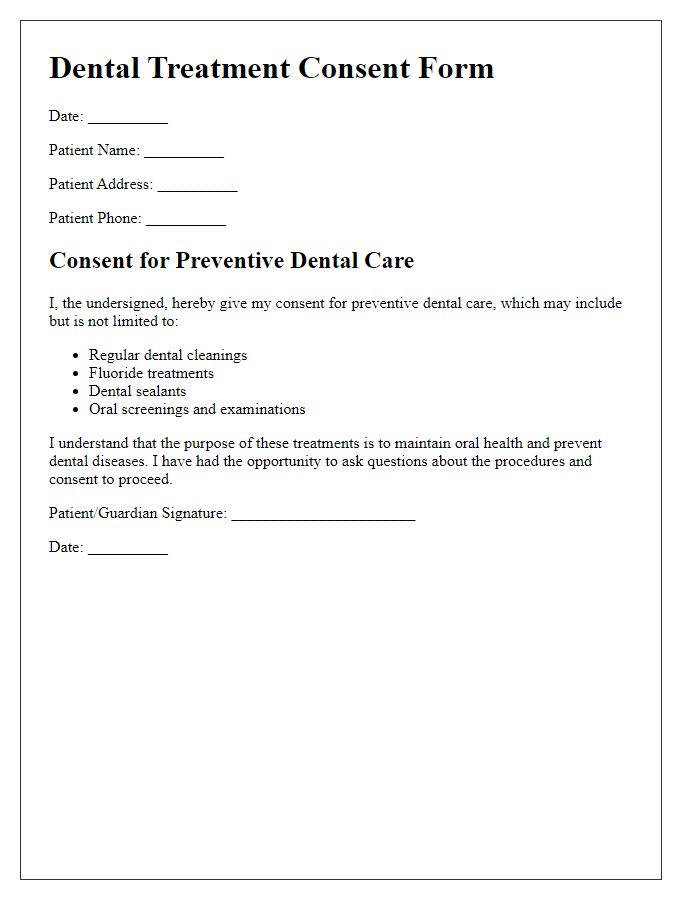When it comes to dental treatments, understanding consent is crucial for both the patient and the practitioner. It not only ensures that the patient is fully informed about the procedures they will undergo, but it also establishes trust between the dentist and the patient. A well-crafted consent letter serves as a valuable tool in outlining the risks, benefits, and alternatives of the proposed treatments. Ready to dive into the essentials of creating an effective dental treatment consent template? Let's explore further!

Patient Information
The dental treatment consent form requires detailed patient information, including full name (essential for medical records), date of birth (to verify patient age and treatment appropriateness), contact information (phone number and email for follow-up appointments), and insurance details (provider name and policy number for coverage verification). Additionally, it is crucial to gather medical history (chronic conditions or allergies that may influence treatment), current medications (to avoid drug interactions), and emergency contact (for patient safety during procedures). This information ensures personalized care and compliance with legal requirements in dental practices, promoting informed consent and effective communication between dental professionals and patients.
Treatment Description
Dental treatment consent involves a clear understanding of procedures, risks, and benefits associated with oral health interventions. For instance, procedures such as root canal therapy, which addresses infected pulp tissue within a tooth, often require the administration of local anesthesia for patient comfort. Additionally, a crown placement procedure, necessary for restoring a tooth's shape and function after decay or damage, may involve multiple visits and laboratory work. Informed consent should outline possible risks associated with anesthesia like allergic reactions, risks of infection, or delayed healing, allowing patients to make educated decisions. Furthermore, it is essential to note alternative treatment options, potential consequences of no treatment, and to confirm patient comprehension of the entire process before proceeding. Providing this comprehensive overview ensures that patients understand their roles in their dental care journey.
Risks and Benefits
Dental treatment procedures, such as root canals or tooth extractions, carry inherent risks that patients must understand. Potential complications include infection at the site, excessive bleeding, or damage to surrounding teeth, which can lead to additional procedures. Benefits include the relief of dental pain, prevention of further oral health issues, and restoration of proper function and aesthetics. Additionally, dental treatments often contribute to overall health by preventing systemic complications related to untreated dental conditions. Understanding these aspects can empower patients to make informed decisions about their oral care.
Alternatives to Treatment
Dental treatments often present various options for addressing oral health concerns, such as cavities or gum disease. Common alternatives include dental fillings (in composite, amalgam, or glass ionomer materials), root canal therapy to save infected teeth, or crowns for damaged teeth. Other options might involve dental cleanings, fluoride treatments, or periodontitis management techniques, which can vary based on individual conditions. Each alternative possesses distinct benefits and potential risks, requiring thorough consideration. Factors such as overall oral health, personal preferences, and financial considerations (insurance coverage or out-of-pocket expenses) significantly impact decision-making for these dental procedures.
Acknowledgment and Signature
Dental treatment consent forms serve as formal agreements between patients and dental practitioners. These documents outline the specific procedures to be performed, potential risks, and patient responsibilities. Acknowledgment section typically includes the patient's full name, date of birth, and the date of the consent. The Signature section requires the patient's handwritten signature, often alongside a witness signature or a guardian signature for minors. This formal acknowledgment ensures that patients understand the dental treatments, such as root canals or extractions, and consent to proceed with informed awareness of any potential complications or alternatives.
















Comments